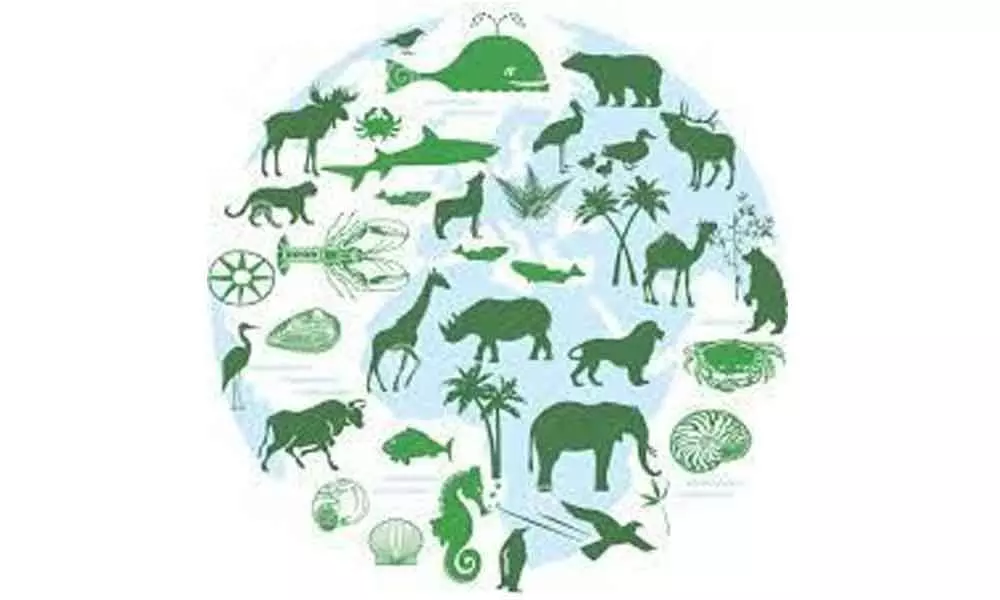Maintaining the delicate ecological balance

Representational Image
To be a living organism, and then, to be a human being living on Planet Earth located in what Australian earth scientist Dr Charly Lineweaver, and broadcaster journalist Stuart Gary, call ‘the Goldilocks‘ zone, is indeed a rare privilege bestowed upon mankind.
To be a living organism, and then, to be a human being living on Planet Earth located in what Australian earth scientist Dr Charly Lineweaver, and broadcaster journalist Stuart Gary, call 'the Goldilocks' zone, is indeed a rare privilege bestowed upon mankind.
Apart from human beings, living organisms of all types inhabit region which covers the areas below and above land, and also a part of the atmosphere above. The whole region goes by the name of the biosphere. While knowledge of the biosphere and its properties belongs to the realm of science, the Greeks, thousands of years ago, worshipped a primordial Goddess, known as Gaia who represented precisely the same region.
The Gaia hypothesis postulates that the organisms, and their surroundings, within it, form an integrated, single and self-regulating system, in which conditions necessary for life to exist obtain .While the theory was viewed with distrust by the scientific community for a long time, it was chemist James Lovelock, and his colleague Lynn Margulis, who, in the 1970s, breathed life into the hypothesis.
The biosphere comprises a wide diversity of physical conditions, and a variety of environments, where life can be found. Each species of living organisms, and the individual members thereof, react in an ordered manner, between and amongst themselves and with other life forms in the biosphere.
The entire system exists in a state of delicate balance, in maintaining which all the species play a significant part. The ecosystem appears the house-like structure one constructs with a pack of cards. Each card represents a different species, and harming any of the species is like upsetting a card in the structure, which can, then, bring down the whole edifice crumbling.
What is required, therefore, is to maintain ecological balance within the biosphere which involves the relations, and interdependencies, between the life forms and the environment. This balance, unfortunately, has, from times immemorial, been impacted adversely upon, the unfortunate phenomenon of man-animal conflict. In recent times, regrettably, the situation has taken a turn for the worse.
Several causes have led to the conflict. Chief among these are the depleting forest cover, caused by activities such as agriculture, mining and construction of irrigation dams. The lack of a well maintained buffer zone between the forests and the outside is also resulting in people travelling deeper into the forest area, in search of fuel wood and water, bringing them into a confrontational situation with the animals in the forests.
This often causes leads to retaliatory action by animals. In fact, studies show that elephants kill more people than tigers and leopards. The infestation of forests with exotic and poisonous weeds, as well as depletion of the prey base of wild animals on account of unregulated poaching, is also resulting in animals straying outside in search of their needs, causing confrontation once again. Roads laid to open up forest areas, not declared as wild life preserves, have also increased traffic, often resulting in accidents and road kill.
Human activities also affect marine life. Activities such as overfishing, introduction of invasive species and pollution impact adversely on the integrity of the marine environment. So does noise pollution, especially for marine mammals, such as whales and dolphins, which depend on echolocation to communicate, navigate, feed and find mates.
Several methods have been tried to contain, if not eliminate altogether, this situation of conflict. Construction of physical barriers around the forest area with barbed wire or solar powered electric fences, relocation of problematic and disadvantaged wild animals to suitable alternative habitats, such as zoos or rescue centres, and increasing the availability of water inside the forest through structures such as check dams and water tanks or some of those.
It is also an established fact that mixed plantations, as compared to monoculture, are more eco-friendly, pest resistant and cause less depletion of soil and water resources.
Providing LPG connections to the inhabitants of the villages on the fringe of the forest areas (tapping, where possible, funds available under the Corporate Social Responsibility regime), and creating awareness among the villages about the need to avoid growing certain species of plantations, such as sugar cane or banana have also been found to be methods which defuse the conflict situation.
Providing financial rewards for the sequestering of carbon, leading to a decrease in the demand for wood as a fuel, also has as a substantially positive impact. Similarly, developing a culture of tolerance in the villages surrounding the forests, and incentivising coexistence of humans and wildlife, whereby animals are viewed as a desirable part of the environment, rather than as pests or threats helps a good deal.
Other methods that have been tried include the constitution of Wildlife Rescue Teams, with communication equipment. Putting in place an SMS alert system that provides early warnings to farmers about possible incursions by animals, providing compensation to the victims of animal attacks to deter them from retaliatory action, are also useful interventions.
Exemplary preventive and punitive penalties should be imposed upon those who violate the regulatory regime in force.One thing is clear. An integrated, determined and holistic effort, inclusive in nature, involving international organisations, country governments, non-Governmental Organisations, communities and Community-Based Organisations, consumers and individuals is a sine qua non of finding a permanent and sustainable solution to this vexing problem
There is definitely, a very positive side also of the animal human relationships. Domestication of animals, especially cattle and horses, "for purposes such as agriculture and transport has been known for centuries. The many purposes for which animal can be used once resulted in an amusing incident. Bullocks had been provided to the tribals of Srikakulam district in Andhra Pradesh state, mainly for farming.
The tribals, however, understood it differently. When the Governor of the Reserve Bank of India came on a visit, and enquired of the tribals how the bullocks were, the reply was, "very tasty!" It was one of the few instances in recorded modern history, when an intended medium term loan was instantly converted into a consumption loan!
(The writer is former
Chief Secretary, Government
of Andhra Pradesh)
(The opinions expressed in this column are that of the writer.
The facts and opinions expressed here do not reflect the views
of The Hans India)




